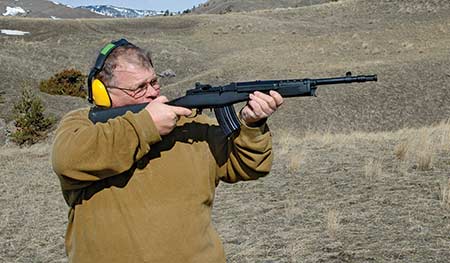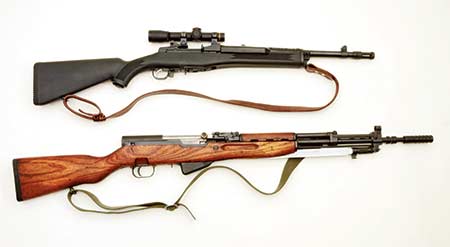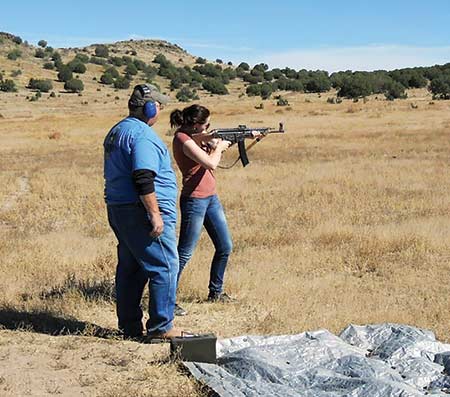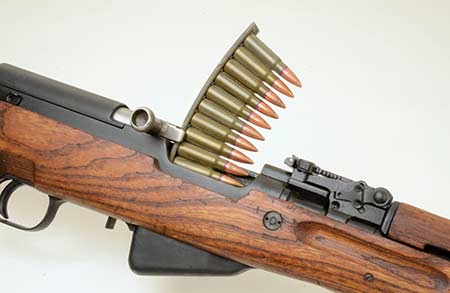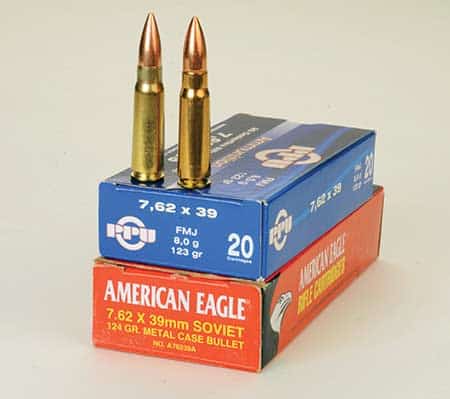Intermediate Cartridges
The Modern Age Of Small Arms Began In The Crucible Of WWII
Intermediate cartridges are all the rage now. There are so many made for the basic AR platform I wouldn’t presume to think I know them all, although I’ve fired AR’s in calibers running from .17 Remington to .50 Beowulf.
From the beginning of smokeless powder rifle cartridges in the late 1800’s until World War II, there were two basic versions. To state it in the simplest of terms, there were big ones and little ones. “Big” as in .30-06 or .30-30 or say .25-35 WCF on the small end of “Big.” Little as in .22 Hornet, .218 Bee, .25-20 and such.
Military organizations worldwide used big ones: 8x57mm Mauser, .303 British, 7.62x54R Russian and so forth. Their rifles likewise were given sights to reach out to near unbelievable distances. The German’s World War II K98k rear sights were graduated to 2,000 meters. The US Model 1903 Springfield’s rear sights went to “27” (2,700 yards).
This was because most militaries’ ordnance senior officers in the first half of the 20th century were dinosaurs. They thought in terms of a mass of troops uniformly setting their sights on the same area and firing on command. In this manner (they thought) a battalion of about 800 or so riflemen could volley bullets on unseen targets such as crossroads or artillery emplacements. As matters worked out, rifle-armed soldiers seldom fired volleys, and combat soldiers shot at what they could see and rarely did all fire every shot on command. They shot when they had a target in their sights, at least if they were well trained they did.
As was the usual case back in those days, the Germans pioneered weapon innovations, and then the rest of the world scrambled to catch up. A WWII standard 8x57mm (actually 7.92x57mm in their terminology) fired a 198-grain bullet of 0.323-inch diameter at a nominal velocity in excess of 2,500 fps. With such power, the K98k could heave that heavy bullet a couple of miles when aimed at the proper angle. However, German officers reported most soldier-to-soldier firing was done at a maximum of 400 meters. A bullet so heavy at such high speed was simply wasting strategic resources such as brass and lead. Also, in fighting against the human masses the Soviets were wont to throw at the Germans, and it was soon realized bolt-action rifles were archaic.
The Germans decided they needed self-loading weapons in the hands of every infantryman, not just self-loading as in semi-automatic. They wanted select-fire, meaning the rifle could switch from semi-auto to full-auto at the push of a button. Of course, the full-auto feature wasn’t meant for 400-yard shooting, which would require slower aimed shots. Full-auto was intended for when the enemy was close, as in coming through the barbed wire.
Therefore the Germans decided to stick with the 0.323-inch diameter for bullets but reduce weight to 125 grains and velocity to 2,300 fps, not only could a soldier pack more ammunition, but the milder cartridge would allow more controllability. The new development was designated 7.92x33mm Kurz, meaning 7.92mm Short. Case length was only 1.299 inches as opposed to the big 8mm at 2.244 inches. Interestingly, the case head for the two rounds remained the same.
At this time, every major military power issued rifles to most infantrymen and submachine guns to select ones––usually sergeants or corporals. By their definition, submachine guns fire pistol cartridges. With a select-fire rifle, the Germans intended to supply one weapon to everyone, and submachine guns and rifles for big cartridges were going to be history (except for snipers). It never actually happened, but the intention was there.
This innovative weapon had many model designations. It’s doubtful so much confusion has ever been attached to a rifle’s name before. It was marked MP (Machinenpistole) 43, MP44 and StG 44 (Sturmgewehr). The latter term translates into Storm Rifle or Assault Rifle. There were other names applied during development but the story is too long for these pages. Here’s a little fact: if the United States Army Ordnance Board had specified a slightly more powerful round than the .30 Carbine with a bit stouter carbine to go with it, America would have been known as the inventor of so-called “assault rifles.”
The 7.62×39 Arrives
The MP43 saw combat in Russia first in 1943. More than likely some of these guns along with their ammunition were quickly captured. Details of the story are murky because the Soviets seldom told the truth about anything. Regardless, a cartridge named M1943 was developed, although it actually saw the light of day in 1944. Sticking with their traditional 7.62mm bullet size (0.310/0.311 inch), the Soviets developed a case 39mm long, which used the exact same case-head design as the German’s 7.92x33mm––ballistically the two rounds were nearly identical. The Soviet 7.62x39mm fired 123/124-grain bullets to about 2,300 fps. (Sources vary but that is a good average.)
The first rifles issued for the new round appeared right after WWII. They were a semi-auto named SKS with 10-round box magazines meant for loading with 10-round stripper clips. SKS rifles were made in virtually most Communist Bloc nations, although it seems the majority showing up here in America were made in China, Yugoslavia, Romania and the Soviet Union. American troops in Vietnam faced them by the thousand.
However, the rifle that made the 7.62x39mm Russian round the world’s most popular choice was, of course, the AK47. Besides being the primary small arm of the North Vietnamese when fighting US troops, the same model rifle is fired at Americans today in many parts of the world. According to the extremely well-documented book The Gun by C. J. Chivers, there have likely been over 100 million AK47’s made worldwide to date, even though the Soviet Union progressed to a 5.45x39mm cartridge in the 1970’s.
As for the savings in strategic materials by switching from big to intermediate cartridges, I have not been able to find German figures in savings. But Mr. Chivers gives the following figures when comparing the Russian’s big 7.62x54mmR to the 7.62x39mm intermediate. For every million rounds produced, the smaller cartridge saves four tons of cartridge case alloy, a ton and a half of gunpowder and more than a ton of lead.
Now to get personal: Early in my gun’riting career, I was primarily a big game hunter and varmint shooter, and I paid not one whit of attention to Intermediate cartridges. Now later in life, following my bent of historical interest, I find myself a shooter and reloader of the first two intermediate cartridges.
Until a few years ago, I would never have dreamed of owning a World War II vintage German MP44. They are amazingly expensive and being capable of full-auto fire, they are strictly regulated by the Federal Government. However, life’s turns surprise you sometimes. I paid the money, filled out the forms and now have one. Hundreds of 7.92x33mm Hornady factory loads and my own handloads have passed through it.
Hornady makes 0.323 inch, 125-grain bullets. For some reason, they are hollowpoints. I laid in a couple thousand when buying my MP44. Prvi Partisan (Serbia) makes fine quality brass and I bought 1,000 rounds.
I freely admit to knowing next to nothing about AK’s of any sort. Although I currently have a Yugoslavian made SKS on hand, I’ve hardly fired it––yet. My shooting experience with 7.62x39mm has overwhelmingly been with Ruger Mini-30s. The following is a detail worthy of note. As said before, the nominal bullet diameter as determined by the rounds’ inventors was 0.310/0.311 inch. However, Ruger uses American .30-caliber barrels on their Mini-30s, meaning 0.300-inch bore and 0.308-inch grooves.
What does this mean? Handloads should use 0.308-inch bullets, and my Lyman dies even came with two case-neck expanding balls. One is for 0.308-inch bullets, the other is for 0.311-inch bullets. So far my reloading has been with Nosler 125-grain .308 bullets. However, I’ve also shot a quantity of Federal and Prvi Partisan (Serbian) factory loads. Pulled bullets from the former measure of 0.309 inches and from the latter 0.310 inches. Currently I have two Mini-30s and both types of factory ammo run through them perfectly.
These Mini-30’s are the Ranch Rifle configuration with synthetic stock and 16-inch barrel extended to 18 inches by the flash suppressor. One wears a 2.5X Leupold scope. The other has just been fitted with a dual-purpose day/night scope (which I will report on once I master its functions). I have 5- and 20-round magazines for them.
My MP44 is stock German military, 16-inch barrel, 30-round magazines, used only outdoors as most were. I’ve had know-it-all types say rather smugly, “Your AK sure has seen better days.” Conversely, those truly in the know do a double take when they see it and timidly ask, “Can I pick it up?”
And my good friend, retired Denver cop and former Thunder Ranch instructor, Rob Rathburn is a good example. When he visited here a few years back, the gun he asked first to try was my MP44.
